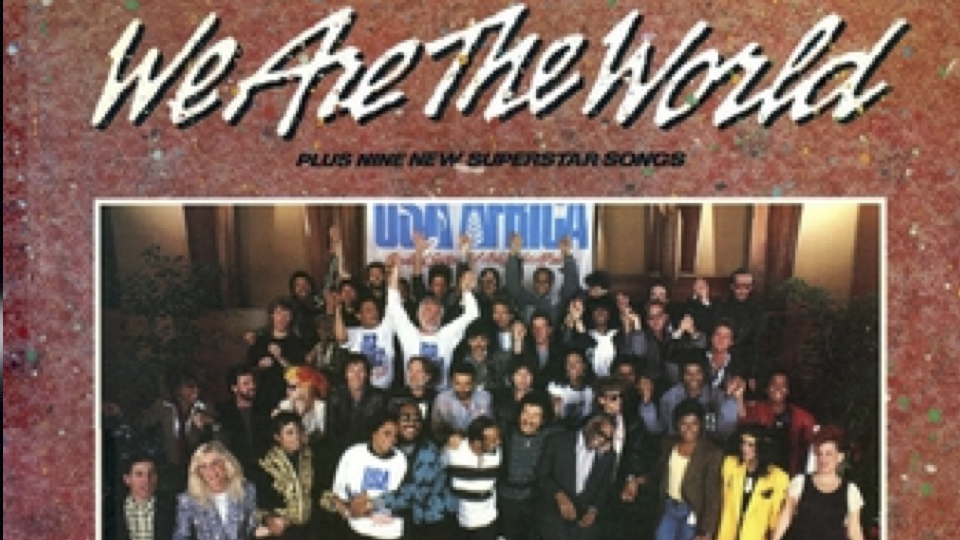For those of a particular generation, the first utterance about USA for Africa’s “We Are The World” elicits an eye-roll followed by a heavy, “Really?” After encountering that song ad nauseam during a certain period of the 80s, let’s break down for the post-1985 generation why it was such a big deal at the time.
Backstory: inspired by the 1984 release “Do They Know It’s Christmas?” by Band Aid that in itself was Bob Geldof’s call to arms regarding Ethiopian famine, musician Harry Belafonte wanted to do the same in the US. He contacted supermanager Ken Kragen – who at the time represented Kenny Rogers and Lionel Ritchie – on December 23 to see who would be interested. In the ensuing weeks, it was Kragen who corralled the most prominent names in the music business to help the cause.
The story here is really of Kragen’s vision. He had wanted to commemorate the memory of his client and good friend Harry Chapin. Chapin – famous for not only his musicianship but his humanitarian aid to end hunger – had tragically died in a car crash in 1981. Kragen in 1985 was seizing on Chapin’s legacy. How could he sway others to jump on board for an important cause?
Kragen had wanted the pairing of Ritchie and Stevie Wonder as the songsmiths, and for Quincy Jones to be the producer. Catching Jones by phone before a holiday trip, he was stunned by this offering: he could get Michael Jackson to sing, sure. And by the way, Jackson wants to co-write this ‘song’ with Ritchie and Wonder. Who. Could. Say. No.
In the ensuing weeks, Kragen made phone calls left and right, wanting it all to gel the night of the American Music Awards on January 28 when a large number of artists would all be in town for that ceremony.
There wasn’t total indifference, but the linchpin was Bruce Springsteen. Kragen told manager Jon Landeau that Springsteen would literally save lives with his appearance. Springsteen was in. But two people Kragen didn’t book – John Denver and Joan Baez, people who had a public-spirited history in humanitarian aid – were left off the list, much to his regret.
The bigger disappointment was Wonder. He had conveniently ‘disappeared’ (either due to commitments or factors unknown) and the song was worked out by Ritchie and Michael Jackson at Jackson’s home. The thunderous inspiration, according to Ritchie, was listening to various national anthems… even though Jackson’s python Crusher went rogue and scared the living bejesus out of Ritchie during the songwriting session.
With no wiggle room on timing, a ‘guide’ demo had to be recorded for the participants. While Wonder showed up saying “I’m ready to write the song!” the studio musicians – drummer John Robinson, bassist Louis Johnson, and pianist Gregg Phillinganes – worked with Jones at Rogers’ Lion Share Recording Studio to get it ready. Jackson sang the guide vocal, duplicates were made and Jones sent the message to those invited: “Please do not make copies, and return this cassette the night of the 28th.”
Today: part of what the general public in our TikTok-tapping, pop culture environment seizes upon first is the song. And the video of the performance via YouTube. It all fits neatly inside a WhatsApp text: “Who the hell are all these people? And who’s that sullen guy in the center of it all?” (Hint: Bob Dylan).
Granted, this portion of the story is about personal opinions. There were some disputes, certainly amongst the gathering: Waylon Jennings got cranky about Jackson wanting to insert faux Swahili and left (the Swahili part didn’t pan out anyway). A new bombshell discovered by this writer: Jones signed on only because he knew a few of the artists that night had contributed to Donna Summers’ 1982 cover of “State Of Independence,” whose choir sounds very much like “We Are The World.” Why? It was a Jones-produced effort.
The solos? All the credit goes to Jones’ vocal arranger Tom Bahler. If you ever had an issue, just imagine the line-up differently and you’ll thank Bahler (himself a songwriter and musician). The biggest jump in the song however came about that night: when Prince (who was invited) didn’t show – either due to nerves or Jackson, the stories vary – Huey Lewis stepped in. Jackson sang him the part and Lewis knocked it out of the park, without breaking a sweat.
Bob Dylan. Much has been written about his performance. “There’s a choice we’re making, we’re saving our own lives.” In the choir, he looked distant and uncomfortable, only springing to life during the impromptu tribute to Harry Belafonte. Yet, with a guiding hand and reassurance, he gave a very ‘Bob Dylan’ performance. Watch the extended outtakes from those moments – asking for Wonder to accompany him, taking cues from Jones, and getting hugs from Ritchie. Pure gold.
Much more can be said about this historic night. Everyone who walked in, whether it was from the AMAs or as Springsteen did, parking his motorcycle across the street, did so because they wanted to be there. The funds raised – around $63 million and continuing to this day – helped abroad and in the US. Willie Nelson was inspired to create Farm Aid. Dionne Warwick released “That’s What Friends Are For” which funded AIDS research, and of course, that summer was the setting for Live Aid.
“Taking this kind of chance is like running through hell with gasoline drawers on,” Jones remarked. When you put together the magnitude of talent that was present that night, don’t get too heated about it. It worked out.
-Amy Hughes
Photo: “We Are The World” (fair use image)




It could in Britain. Geldof would command it.
Nice piece.